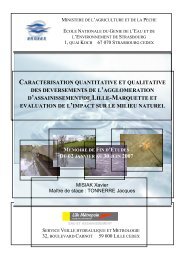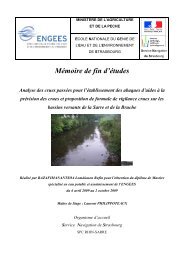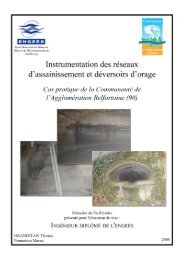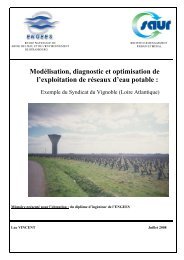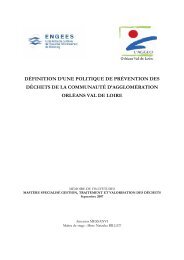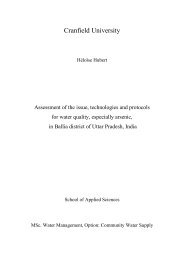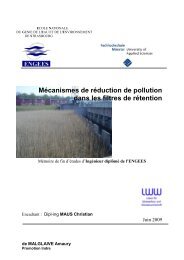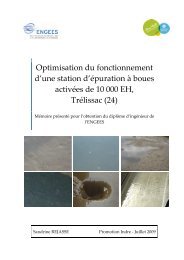Evaluation of water supply system Case study in Naka ... - ENGEES
Evaluation of water supply system Case study in Naka ... - ENGEES
Evaluation of water supply system Case study in Naka ... - ENGEES
- No tags were found...
You also want an ePaper? Increase the reach of your titles
YUMPU automatically turns print PDFs into web optimized ePapers that Google loves.
<strong>Evaluation</strong> <strong>of</strong> <strong>water</strong> <strong>supply</strong> <strong>system</strong> – <strong>Case</strong> <strong>study</strong> <strong>in</strong> <strong>Naka</strong>, NigeriaBox 1 : Nigeria Pr<strong>of</strong>ilePopulation: over 130 millionPopulation growth: 2.38%Liv<strong>in</strong>g <strong>in</strong> absolute poverty: 75 million (58% <strong>of</strong> total population)Life expectancy: 43 yearsInfant mortality: 198/1000Water <strong>supply</strong> coverage: 60%Sanitation coverage: 38%Human development <strong>in</strong>dex: 158Adult literacy: 67%International development Assistance: $2 per capita(average $21 per capita <strong>in</strong> sub-Saharan Africa)(Sources: DFID, 2006; Wateraid 2005; CIA, 2006)Nota: <strong>in</strong>formation varies significantly between different sources, mean<strong>in</strong>g thatnational <strong>in</strong>formation are not always precise, sometimes underestimated.1.2 Small Town contextThe emphasis <strong>of</strong> <strong>water</strong> projects on small town areas is relatively recent. In the past,the attempt to apply management options taken from urban or rural areas <strong>of</strong>ten lead t<strong>of</strong>ailure (Price, 2002). There are no specific types <strong>of</strong> small town; they are def<strong>in</strong>ed as“settlements sufficiently large and dense to benefit from the economies <strong>of</strong> scale<strong>of</strong>fered by piped <strong>system</strong>s but too small and dispersed to be efficiently managed by aconventional urban <strong>water</strong> utility, usually with a population between 5,000 and50,000” (Roche, 2000). In Nigeria, socio-economic surveys <strong>of</strong> 37 small towns <strong>in</strong> 1997look<strong>in</strong>g at people’s will<strong>in</strong>gness to pay concluded that “it is possible to developf<strong>in</strong>ancially viable <strong>water</strong> <strong>supply</strong> and sanitation solutions <strong>in</strong> Nigeria’s small towns”(Stoveland, & Bassey, 2000).1.3 Project contextWaterAid has been present <strong>in</strong> Nigeria s<strong>in</strong>ce 1995 for development projects concern<strong>in</strong>g<strong>water</strong> and <strong>in</strong> 2005 it proposed Partners for Water and Sanitation (PAWS) to worktogether. These two partners, associated with the M<strong>in</strong>istry for Water Resources andEnvironment (MWRE) <strong>of</strong> the Benue State Government (BESG) are currentlyreactivat<strong>in</strong>g projects focused on small towns <strong>in</strong> Benue state. The aim is to create andbuild the capacity <strong>of</strong> community-based organisation, Water Consumer Association(WCA), so that they are able to operate and ma<strong>in</strong>ta<strong>in</strong> the <strong>water</strong> <strong>system</strong> <strong>in</strong> theirCranfield University at Silsoe 2 Florianne Bourrigault (2006)




